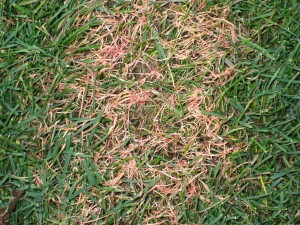Spring and early Summer in Wyckoff, NJ has been wetter than usual. While not at record levels, the excess rain and cool temperatures bring about the eternal problem of fungus on the lawn. Some of the most common fungi we see in this area are red thread, leaf spot, and mushrooms.
Most common fungi
Red thread fungus (Laetisaria fuciformis) occurs after periods of prolonged cool and wet weather. It starts as bleachy-looking patches in the lawn. Soon after, red or pinkish threads appear, some of which can grow to almost an inch above the height of the grass blade. The disease usually hits in the springtime in our area, but the spores can survive in the ground through the winter cold and summer heat for up to 2 years.
Leaf spot (Helminthosporium) has its beginnings in the cool wet weather of spring, but generally doesn’t rear its ugly head until it becomes hot and humid, known as the ‘melting out’ phase. The grass blades develop oval, straw colored spots surrounded by dark rings. Eventually the grass blades turn yellow and die, and if left untreated, leaf spot can eventually kill the entire crown.
Treatment of Lawn
Regardless of which fungus your lawn has, the treatment prescription is the same – arrest and recover. When the weather is wet, fungus is going to happen, no matter how well cared for your lawn is. It is no surprise, however, that a well cared for lawn will recover far more quickly from the attack. The most important thing you must do when you see the first signs of a fungal infection is to stop it dead in its tracks by applying fungicide. Different fungicides treat different diseases, just as doctors choose antibiotics based upon the type of infection you have, so it’s important to choose the right product. Your lawn care professionals at Horizon Landscape know what products work best. If you plan on treating the disease yourself, ask your local garden center for help.
Fungicide’s only purpose is to kill the fungus and stop the spread of the disease. It will not prevent new fungal infestations, so it is important to keep an eye on your lawn during periods of heavy moisture. A fungicide application is effective, at best, for 14 days, so during rainy spells it will need to be applied more often, since the rain cuts down on its potency. Continue to apply fungicide until you see that the infection is no longer spreading.
Lawn Recovery
Once the fungus is arrested, the lawn must recover on its own. Fertilizer is the best weapon in helping with the recovery, and having a regularly scheduled fertilizing program with your lawn care professional will ensure that your lawn gets fed when it needs it. Aerating your lawn in the fall also helps to deliver oxygen to the soil and dry out dormant fungus spores that are waiting patiently for the following spring to wreak havoc once again.
And last, but not least, our most notorious fungal friend – the mushroom. They come in all shapes and sizes, all colors and textures. And there’s not a darn thing you can do about them except pick them. If you have small children and pets, I would suggest doing a ‘mushroom check’ every morning during periods of wet weather, because they spring up quickly, and some are poisonous. Unfortunately, by the time you see a mushroom, it has already developed a root system underground – the mushroom is simply the bloom. So picking them gets them out of sight, but they’ll be back. Aerating the lawn does help with breaking up the mycelium strings that form underground so that the mushrooms need to rebuild before they can bloom.
Today’s title is a line from Sylvia Plath’s 1959 poem, “Mushrooms” – she seems to capture the thoughts of the little buggers very well:
“Overnight, very whitely, discreetly, very quietly our toes, noses take hold on the loam, acquire the air. Nobody sees us, stops us, betrays us; the small grains make room.
Soft fists insist on heaving the needles, the leafy bedding, even the paving. Our hammers, our rams, earless and eyeless, perfectly voiceless, widen the crannies, shoulder through holes. We diet on water, on crumbs of shadow, bland-mannered, asking little or nothing.
So many of us! So many of us!
We are shelves, we are tables, we are meek, we are edible, nudgers and shovers in spite of ourselves. Our kind multiplies: we shall by morning inherit the earth. Our foot’s in the door.” ~ Sylvia Plath
And after several rainy days, you may wake up to find that, indeed, they have.

